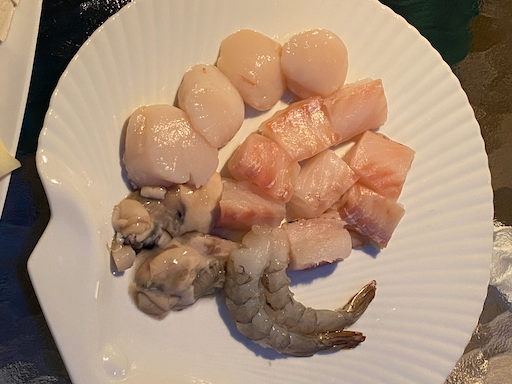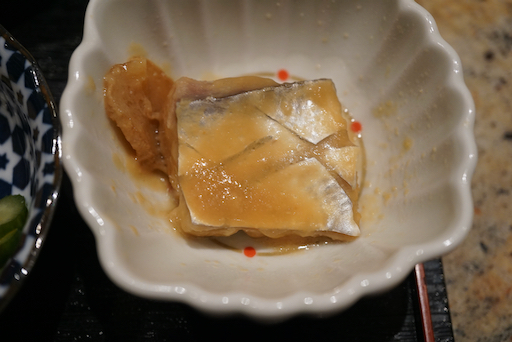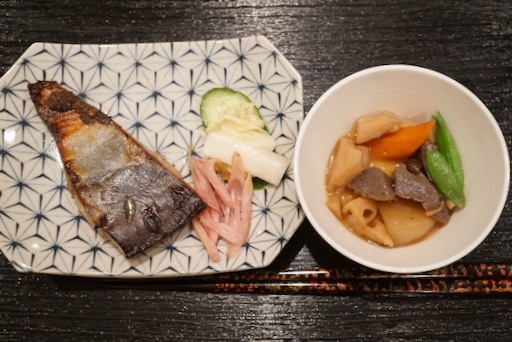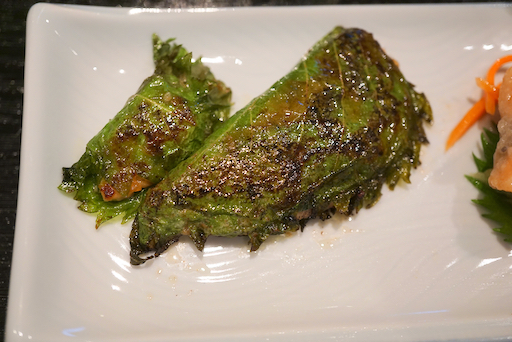Wednesday, February 24, 2021
Seafood nabe on a snowy day 雪降りの夕の海鮮鍋
Saturday, December 19, 2020
Appetizers 4 kinds お通し4種類
Ingredients:
3 Japanese eggplant
2 tbs neutral vegetable oil
two small pieces of ginger, crushed with the side of the knife.
250ml Japanese dashi broth (I made this with my usual bonito and kelp dashi pack)
3 tbs soy sauce
3 tbs mirin
(Instead of soy sauce, I am using "shirodashi" 白だしand light colored soy sauce).
Directions:
Cut the eggplants in half lengthwise. Shallowly cut the skin in crosshatching pattern and then cut lengthwise again to make 1/4 eggplant.
Add the oil to a frying pan on medium flame and add the ginger for a few minutes until fragrant.
Add the eggplants skin-side down and fry for 3-4 minutes and turn over to fry both of the fresh sides for 2-3 minutes each,
Add the seasonings and broth (below), put on the lid and simmer for 3-4 minutes.
This is good eaten hot right after it is cooked but it can also be stored in the broth in a sealable container in the refrigerator. The stored eggplant can be eaten cold or heated up in the microwave.
This is usual salmon nanban. This one was really good since the quality of the salmon (from Whole foods) was good and I did not over cook it. I served this with sugar snap in salt broth スナップ豌豆の塩びたし.
Mr. and Mrs. Segawa of Tako Grill kindly gave us "kazunoko" herring roe 数の子. I prepared it as I described in my New Year dish tab. The half serving shown below was soaked in dashi broth with soy sauce and mirin seasoning. I marinated the other half serving in sake-lee and miso mixture or "kasu-miso" 粕味噌. Since this preparation will last longer than the one soaked in dashi broth we will eat it closer to the holidays.
I also served Spanish mackerel in miso sauce 鯖の味噌煮. (The red dots surrounding the mackerel are part to the decoration of the bowel not part of the preparation.)
This was a quite a good starter line up for the evening.
Sunday, November 29, 2020
Yellowtail marinaded in sake lee ハマチの粕漬け
This was the last of the whole fresh yellowtail. I marinated the filet in sake lee 酒粕 or "Kasu-zuke" 粕漬け. Since I did not have a time to cook this during the week, the fish marinated for a week which was a bit too long. I also made Japanese stewed vegetable "nituske" 煮付け as a side.

Ingredients:
Sake lee 300grams
Red miso 30grams
Sugar 3 tbs
Salt 1/2 tsp
Sake to loosen up the marinade if too stiff,
Directions:
I added half of the sake lee mixture in the bottom of a sealable container and placed cheese cloth (after washing to remove any lint). I put in the filets and then covered them with another layer of cheese cloth. I put the remaining sake lee mixture on top. I let it marinate in the refrigerator (for a week as it turned out).
This was a bit over-marinated. I started broiling on the flesh side first as shown below in the toaster oven.
Thursday, November 26, 2020
Yellowtail burger はまちバーガー
I was trying to use all parts of the whole yellowtail I got from Hmart through Instacart. I scraped off all the meat from the bone as well as the meat close to the end of the tail. I minced it but the amount was not enough to make a substantial dish. So I decided to make a yellowtail burger. As a binder and to make the "meat" go further I added “hanpen ” はんぺん. It is steamed Japanese fish cake made of white fish meat and egg white and came pre-made in a package. I served the resulting burger as a lunch with leftover shiitake mushroom risotto, sautéed pencil asparagus and scrambled egg with tomato.

Ingredients:
Yellowfin meat scraped off from the bone and the end of the tail, finely minced (I am not sure how much this was but probably less than 200 grams)
1/3 hanpen, thawed, cut into small cubes
1/2 egg, beaten
2 shiitake mushroom, both stalks and caps finely chopped
1 tsp of red miso
1/2 tsp mirin
Pinch of salt
Vegetable oil for cooking
Directions:
In a plastic cylinder (which came with the emersion blender), add the hanpen and the egg. Using the emersion blender make a smooth mixture. Add the miso and the seasoning and blend. Add the yellowtail meat and mix with a silicon spatula. Dump the mixture on a lightly oiled plate, divide in half and form two oval disks, half inch thick. In a non-stick fry pan, on medium-low heat add the oil and slide in the disks. I cooked one side about 5 minutes and turned the burger over and cooked another 3-4 minutes until done.
This was rather gentle tasting and tender fish burger. The miso flavor really made it. This was nice light lunch.
Monday, November 23, 2020
Simmered yellowtail head ハマチの兜煮
For many non-Japanese (and even for some Japanese I suppose), this may not look attractive but stewed fish head is a classic Japanese dish and does have a quite good amount of meat to enjoy. Even my wife likes stewed fish heads. I made this from the yellowtail fish I bought recently from Hmart and was part of my effort to make sure none of the fish went to waste. The classic fish used for this dish is perch or “Tai” 鯛. I have made this using salmon head which was very good. This yellowtail head was not very big (I should not have removed the collar or “kama” which I froze for later use. It would have added more meat). I simmered the head in seasoned broth with daikon.
Ingredients: (for two servings)
One yellowtail head, cut into two lengthwise (requires a heavy chef’s knife)
Daikon, peeled and cut into 4 one inch thick rounds
Ginger, 4-5 slices
100ml sake
100ml water
2tbs mirin
2tbs soy sauce
1 tsp sugar
Directions:
Place the two halves of the fish head in a sauce pan (they should fit snuggly).
Add the sake and water and simmer for 10-15 minutes with folded aluminum foil as an inner lid or “otoshi-buta” until cooked through.
I served the fish heads with daikon and added sugar snaps cooked in salt broth スナップ豌豆の塩びたし. This was quite good. The seasoned broth was a flavorful part of the serving as were the daikon which absorbed the flavor or the broth and were nice and tender. The fish cheek meat, as is the case with other meat sources such as beef or pork was the best part of the stew. Next time I will not remove the collars since they would have provided a bit more meat.
Saturday, November 14, 2020
Grilled yellowtail filet ハマチの塩焼き
Choosing among the whole fresh fish available from HMart Korean grocery store, we tried "yellowtail" this time. The Japanese name may be "hamachi" ハマチ but the Japanese name changes as this fish grows. If the fish is over 80 cm, it is called "Buri" ブリ which appears to be the uniform nomenclature throughout Japan. The younger, smaller yellowtail, however, has many different names depending on the locale. The one we got may have qualified as a small "hamachi". Of course, the best way to enjoy hamachi is as sashimi, but this one was not fresh enough for that. So, after I cleaned the fish I made what is known in Japanese as sannmai-oroshi 三枚おろし or “three layers” which consist of two filets and a central layer of bone with bits of meat still attached between the bones. I cut one of the filets into serving size, salted it and let it stand in the refrigerator for several hours. I blotted the surface with paper towel, re-salted and cooked it. It would have been best grilled over a charcoal fire but I simply cooked it in a frying pan with a small amount of olive oil. I served it with salted vegetables 浅漬け (Cucumber, nappa cabbage, thick rectangles of daikon), myoga in sweet vinegar 冥加の甘酢漬け and blanched broccoli. I found that we had a chopstick rest shaped like myoga so in keeping with the theme included it for the chopsticks on the tray. This dish was quite good with cold sake.
I cut the two filets into small serving size. I cooked one of the filets as shown here. I marinated the other filet in sake lee ハマチの酒粕味噌漬け. I simmered the heads as "Kabuto-ni" 兜煮, and the collars or "Kama" カマ were frozen for later. I also scraped off all the meat from the bone and also removed the meat from skin of the tail portions and used it to make a yellowtail burger ハマチバーガー (all the subjects of future posts). So every part of the fish, except the bones and fins was used— nothing was waste. In so doing I hope we did justice to what this lovely fish had to offer.
Friday, October 30, 2020
Grilled bluefish and matsutake lunch
We used to get a whole fresh Spanish mackerel at Whole foods, but it has not been available for a long time. Since we started buying groceries from the Korean grocery store HMart through Instacart, we have found they have more variety of whole fresh fish available. We got whole Spanish mackerel from them a few times. This time, however, mackerel was not available but bluefish was. We have used bluefish* in place of Spanish mackerel in the past and decided to go with it. I am not sure how I ordered it (by weight or by the numbers) but I ended up with two rather large bluefish not cleaned at all. So, I had to scale, gut, remove head and make filets. It was a bit of work but the fish was really fresh. As before, I made bluefish simmered in miso sauce ブルーフィシュの味噌煮 from the filets and "tsumire" fish balls soup つみれ汁 from the fish meat scraped off the bones. I set the fish ball soup and miso simmered fish aside for another meal. The remaining filets, I salted and grilled. We happened to have matsutake 松茸 from Oregon mushroom and matsutake rice 松茸ご飯 rice leftover from dinner the previous night. So I made matsutake soup 松茸のお吸い物, warmed up the rice and served with the bluefish for our lunch on Sunday.
* I am not sure of its Japanese name but it appears to be "Oki-suzuki" オキスズキ. I have not seen or eaten it while I lived in Japan.
I first salted the fillet and let it sit in the refrigerator for a few hours. I cooked the bluefish filet with a small amount of olive oil in a frying pan on low flame with skin side down until the skin got brown (6-7 minutes, I also applied decorative cuts on the skin to prevent the skin breaking during the cooking). I cooked 80% on the skin side, flipped it and completed the cooking. I served this with pickled myoga 冥加の甘酢漬け, salt picked cucumber and nappa cabbage きゅうりと白菜の浅漬け and thinly sliced cucumber dressed in sushi vinegar 胡瓜の酢の物. Since the fish was well-salted, we did not need additional sauce such as soy sauce for this.
For the matsutake soup 松茸のお吸い物, I made bonito "dashi" カツオの出汁 from a dash pack seasoned with mirin and light colored soy sauce and salt, added thinly sliced matsutake, silken tofu, "kyoubu" 京麩 decorative gluten cake (dried, hydrate before adding to the soup), freeze dried "mitsuba" 三つ葉 and yuzu zest ゆず (frozen).
The bluefish prepared this way was very good. The flesh was pleasingly oily, soft and had a nice flavor. The skin did not get crispy but stayed soft. It may have been a bit strong tasting fish to accompany the delicate matsutake but we really enjoyed this lunch.
Tuesday, October 13, 2020
Special take-out Kaiseki box from Sushi Taro 寿司太郎のテイクアウト特製会席弁当
Prior to COVID the omakase counter at Sushi Taro was our special-occasion-go-to place. As a matter of fact, we had a reservation in March this year but because of COVID, that got canceled. I knew for some time that, although the restaurant was closed, Sushi Taro has been doing take-out. But getting there either from home or work for the pick-up was impractical. Since I started thinking about the NewYear “Osechi” 御節 from Sushi Taro, I contacted them. I was delighted to find out that they are going to do Osechi for the next New Year and I quickly placed an order. During that interaction, I learned that they do special omakase kaiseki boxes-to-go and that they can deliver. I quickly placed an order. Delivery was scheduled for Friday at 5pm. We were like little kids in anticipation. I even "just happened" to come home from work a bit early for the delivery. It arrived in two, two-tiered (bento or modified jubako?) boxes. (a total of four boxes with three compartments each). We initially thought we got two identical sets but when we opened the second box, surprise! We were totally blown away. All compartments contained many wonderful different dishes. The first one had some cooked dishes, two different kinds of sushi. The cooked dishes in the top tier were still warm.
Saturday, October 10, 2020
Grilled mackerel salad with “Yuzu” mayonnaise 柚子マヨあえ焼き鯖のサラダ
This is a small salad made of leftover salted and grilled mackerel 鯖の塩焼き. I just came up with this and did not have any recipe.
Monday, September 28, 2020
Salted and grilled mackerel 鯖の塩焼き
Come to think of it, I never cooked mackerel this basic way. When I got two whole Spanish mackerels from HMart via Instacart, there was too much to make it all into the miso-simmered dish 鯖の味噌煮 I usually make. So, I took two filets I prepared from the smaller of the two fish and made this salted and grilled mackerel. I filleted the fish and removed the small pin bones. Then I cut one filet into two and salted both sides. I let it stand for 10 minutes and blotted the surfaces using a paper towel. I made shallow cuts on the skin and re-salted it. Since I do not have a Japanese style fish grill and I did not want to cook fish in the toaster oven, I sautéed the fillets in a frying pan with a small amount of olive oil.
This is a basic simple way of cooking mackerel but it was good. On the side, I added sliced mini-cucumber (salted and moisture squeezed out) dressed in sushi vinegar. Since we had just harvested and pickled myoga, I added it too. This could have gone very well with rice. We had it as a drinking snack with cold sake.
Thursday, August 27, 2020
Red wine miso sauce with tuna cutlet 赤ワイン味噌ソースとマグロカツ
I thawed a block "saku" of low-grade yellowfin tuna sashimi. As usual, I tried to make some variation dishes. First I made "zuke" marinated tuna cubes with avocado very similar to one I posted. The second dish was imitation "negitoro " ネギトロ. These two dishes are very good with cold house sake "Tengu-mai" 天狗舞大吟醸. The third dish I made was tuna cutlet マグロカツ. I gave a twist to this dish by making a red wine miso sauce and serving it with our relatively new house red wine DAOU Vineyards “Pessimist” Red Blend 2018. I saw the sauce recipe in a digital version of the Japanese newspaper “Asahi “ 朝日新聞. The recipe was written by a sommelier. It is a reduced red wine with miso and he claimed that, with this sauce, the food will go well with red wine. He also suggested fried food would be the best with this sauce. I served tuna cutlet with this sauce accompanied with cucumber and cabbage “asazuke” 浅漬け as well as the cauliflower I usually make and skinned Campari tomato.
The reason I made this sauce was because one of the bottles of red wine we opened recently had a bit of a musty taste/oder and we decided not to drink it. It was not corked but somehow the handling was not right since other bottles of the same wine were ok. Also we have had this wine so many time in the past with no problems. In any case, I used a portion of this wine to make a chicken liver dish, a stew of leftover barbecued chicken, and this red wine miso sauce to finish the bottle. Once cooked, the wine lost its mustiness.
IngredientsRed wine 200 ml
Red miso 2 tbs (I did not have red miso 赤味噌 and used “awase” miso 合わせ味噌)
Mirin 2 tsp
Rice vinegar 2 tsp
light colored soy sauce 2 tsp
Honey 2 tsp or more to taste
Reduce the red wine in half, dissolve the miso and add other ingredients and adjust sweetness to your liking by adding more honey.
I added more honey than indicated. I had to strain the sauce since it developed some sediments (due to vinegar?). I served it on the fried tuna and the fried taste completely dominated. We actually couldn’t taste the sauce at all. My wife, who never skimps when it comes to the application of sauces actually took to soaking her pieces of tuna in the sauce and said she still couldn’t taste it. Finally, in desperation she slurped it with a spoon and conceded it tasted very nice. I would have expected to at least taste the miso flavor but it was completely muted. I am not sure this may have been because I did not use red miso. In any case, this sauce did not have much flavor but we enjoyed the tuna cutlets with red wine. Since more sauce is left, I may add more miso to see if that will improve the flavor.
Friday, July 31, 2020
Red wine "Zuke" tuna and avocado 鮪の赤ワイン漬けとアボカド
Ingredients: (appetizers for two)
1/2 block of sashimi tuna (in our case, frozen yellowfin), thawed if frozen, cut into small cubes
1/2 ripe avocado
Marinade:
3 tbs red wine (I had an open California cab).
2 tbs soy sauce (I reduced the soy sauce from the original recipe)
1 tbs mirin
1/4 tsp dark sesame oil
In a Ziploc bag, add the marinade and tuna cubes. Remove the air as much as possible and let it marinate in the refrigerator for a few hours (in my case, it was close to10 hours).
Just before serving, take out the tuna cubes, blot off the excess marinade using a paper towel.
>Remove the stone and skin from the avocado, cut into bite-sized pieces, dress with either lemon juice or yuzu juice (to prevent discoloration, I used yuzu juice from the bottle).
Mix the tuna and avocado in a bowl ( I added a few more drops of Yuzu juice).
Serve on the perilla leaves and garnish with a chiffonade of perilla and some sesame seeds.
Saturday, July 25, 2020
Horse mackerel wrapped in perilla leaves 鯵の大葉バター焼き
4 raw jack mackerel or "aji" filets (thawed if frozen)
1 tbs miso
1 scallion, finely chopped
1/2 ginger, finely chopped
1/4 tsp soy sauce (optional)
1/4 tsp sugar
10 perilla leaves, washed and dried with stem end removed
Butter for frying
Directions
I first made "namerou" by chopping and pounding the aji with a sharp knife until the aji became a bit pastey. I mixed in the scallion, ginger, miso and sugar and kept pounding until well mixed. You could add a bit of soy sauce to adjust the seasoning and consistency. I placed a small amount of namerou on a perilla leave and folded it into half-moon shape (below)


















































